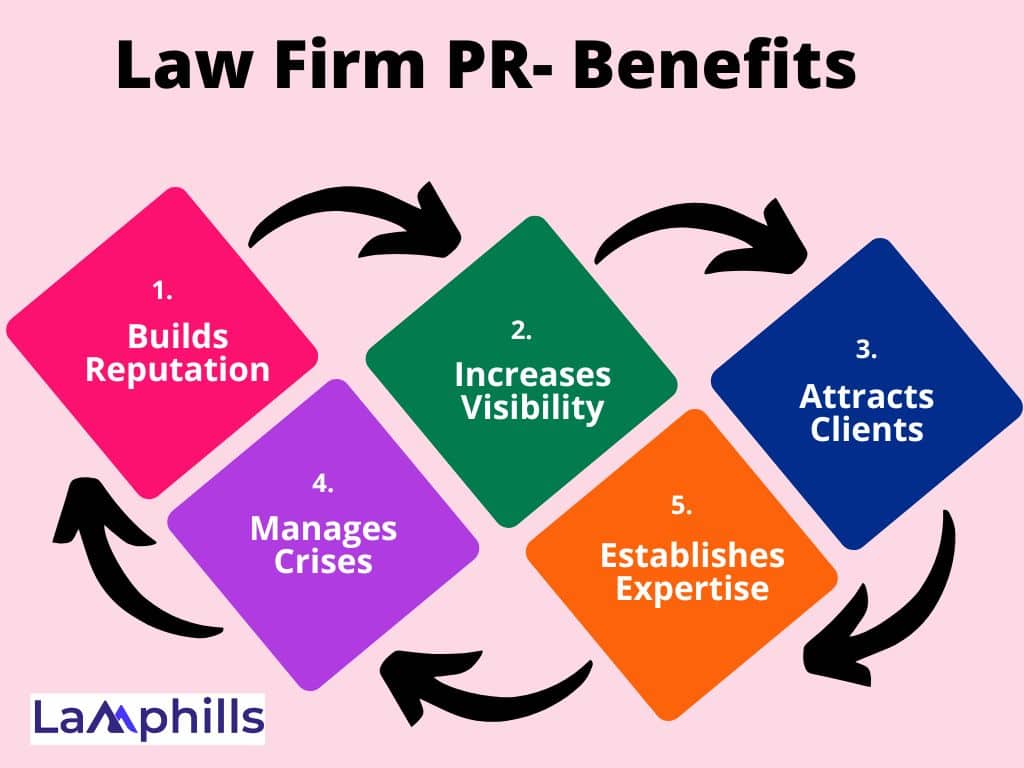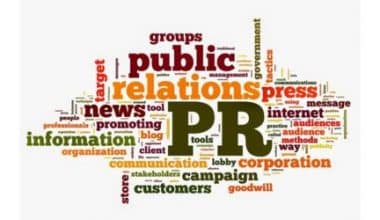A law firm’s Public Relations (PR) is about managing its reputation and promoting its services to attract clients. It involves communicating effectively with the public, the media, and potential clients. The goal is to build trust, showcase expertise, and create a positive image of the firm.
Even the best lawyers can struggle to get noticed in the crowded legal market. Despite their skills and hard work, potential clients might not be calling, and their reputation stays the same. The reason? Often, it’s because of poor public relations (PR) strategies.
A law firm’s success depends on how the public views it. Now, more than ever, lawyers need to actively shape this image. Traditionally, this meant writing press releases and attending industry events. However, the role of PR for law firms has grown much wider in recent years.
This guide is designed to help you understand the many parts of law firm PR. Keep reading to learn how to create a strong PR strategy and get valuable tips to boost your firm’s reputation.
Key Points
- Public Relations (PR) is crucial for law firms to manage their reputation, attract clients, and build trust. Effective PR strategies help law firms stand out in a competitive market by showcasing their expertise and creating a positive image.
- PR offers numerous benefits including building a good reputation, increasing visibility, attracting clients, managing crises, enhancing online presence, establishing expertise, building relationships, and supporting business growth. These benefits collectively contribute to the overall success and growth of a law firm.
- An effective PR strategy for law firms includes branding, media relations, SEO and content marketing, social media engagement, networking, client testimonials, crisis management planning, and the use of technology. Each element is crucial in enhancing the firm’s image and attracting clients.
- Measuring the success of PR efforts involves tracking media coverage, monitoring social media engagement, analyzing website traffic, collecting client feedback, measuring new client inquiries, and using PR tools. These metrics help law firms evaluate the effectiveness of their PR strategies and make necessary adjustments.
What is Public Relations for Law Firms?
In simple terms, Public Relations (PR) for law firms is about shaping how people see your firm. It involves using different methods like press releases, events, blogs, articles, and podcasts. Good public relations can make your firm more visible, improve its reputation, attract new clients, and strengthen relationships with current clients.
I spent the early years of my career as a Legal Assistant in a well-known law firm. Over these eight years, I saw many changes in how the firm was run. The firm moved from the old-fashioned methods to using digital tools. Now, they have a website that shows past cases and the legal services they offer. They also have an online system that tracks the cases assigned to lawyers and provides detailed reports on each case, including clients’ financial information and more.
This not only boosted the firm’s reputation but also attracted new clients and made our law firm stand out as the best among other law firms in our vicinity. This change has taught me a lot about how law firms can use digital PR to build their reputation and connect with clients.
Law Firm PR is not just about dealing with crises; it’s about building and keeping a good reputation. In 2024, the legal market will be very competitive, and clients will be picky. They don’t just want good lawyers; they want to work with firms that have a good public image.
Read Also: What Is the Role of Public Relations in Marketing?
The Benefits of Public Relations for Law Firms
Bill Gates once said, “If I was down to my last dollar, I would spend it on public relations.” This shows how important PR is. You might have one of the best law firms that focuses on clients, but if people don’t know about it, growing your business will be hard. Public relations is, therefore, a key tool to share your successes and show your expertise to more people.

Here are some reasons why PR should be a priority for your law firm:
#1. Builds Reputation
In my years of experience at the law firm, I saw how good public relations helped build our reputation. Positive news stories and online mentions made people trust us more. This trust attracted more clients
Public relations help law firms build a good reputation. When people hear positive things about a firm in the news or online, they are more likely to trust and hire that firm. This applies to both current and future clients.
#2. Increases Visibility
When we were mentioned in articles or appeared on TV, more people learned about us and what we do. This helped us stand out and made both old and new clients aware of our services and strengths.
Good PR strategies can make a law firm more visible. When a firm is mentioned in articles or interviewed on TV, more people learn about them and what they do. This goes a long way to helping your firm stand out in a crowded legal market and also makes sure potential clients know about your services and strengths.
#3. Attracts Clients
When people heard good things about us, they were more likely to choose our firm. I remember one time, a client recommended the firm to his friend. The firm’s reputation and visibility were key to attracting more clients.
Highlighting your firm’s expertise and successes through PR campaigns can attract new clients and increase revenue. Also, when a law firm has a good reputation and high visibility, it attracts more clients. People are more likely to choose a firm they have heard good things about.
#4. Manages Crises
In a crisis, PR is essential for managing and shaping how the public views your firm. If a law firm faces a problem or bad publicity, good PR can help manage the situation. PR professionals can help the firm respond quickly and effectively to protect their reputation.
#5. Boosts Online Presence

Public relations includes managing a firm’s online presence. This means keeping the firm’s website, social media, and online reviews positive and up-to-date. When you share content across different platforms, it can boost your firm’s search engine rankings, making it easier for people to find you online.
#6. Establishes Expertise
PR showcased our firm’s expertise. Our lawyers were featured in articles or speaking at events, and we were seen as experts in our field. This enhanced our credibility and attracted more clients.
Public relations can showcase a firm’s expertise. By getting lawyers featured in articles or speaking at events, the firm is seen as an expert in their field.
#7. Builds Relationships
PR helps law firms build relationships with the media, clients, and the community. Strong relationships can lead to more business opportunities and partnerships.
#8. Supports Business Growth
Overall, good public relations support the growth of a law firm. By building a strong reputation, attracting clients, and managing their image, PR helps the firm expand and succeed.
These benefits show that effective PR helps law firms stand out in a competitive market, connect with the community they serve, and also boost the overall success and growth of a law firm.
Channels for Law Firm PR
The law firm’s PR involves talking to the public, the media, and potential clients to create a positive image. It includes activities like writing news stories, posting on social media, hosting events, and writing articles. The basic channels for getting these activities across to the public or potential clients are:
1. Media Outlets: Newspapers, magazines, TV, and radio are traditional media outlets where law firms can share their news and stories. Being featured in these outlets helps increase visibility and build a positive reputation.
2. Social Media: Platforms like Facebook, Twitter, LinkedIn, and Instagram are great for connecting with people directly. Law firms can share updates, and legal tips, and interact with clients and the community on these platforms.
3. Press Releases: A press release is an official statement sent to the media to announce important news, such as a new hire or a big case win. It helps law firms get their news out to a wide audience quickly and efficiently.
4. Events and Speaking Engagements: Participating in or hosting events, such as seminars, webinars, and conferences, allows law firms to showcase their expertise and build relationships. Speaking at these events also positions the firm’s lawyers as experts in their field.
These channels help law firms effectively communicate with the public and build a strong, positive presence.
What are the Essential Elements of an Effective Law Firm PR strategy?
Creating a good PR plan for your law firm needs careful planning. You need to include the right steps, involve the right departments, and have the right team members to make sure your PR efforts are focused on getting results. Based on my experience, here’s a simple guide to how my law firm was able to succeed using PR and how law firms can also succeed in PR in 2024.
#1. Branding

This is about making sure people know who your law firm is and what it stands for. You need a clear identity that sets your firm apart from others. This includes a recognizable logo, a consistent color scheme, and a unique message that tells everyone what your firm values and excels at. Think of it like creating a personality for your law firm that people can remember and trust.
In the beginning, our firm mostly got clients through word-of-mouth and personal referrals. But as we moved into digital PR, having a professional and informative website became essential. A good website should show the firm’s skills, list its services, and highlight notable cases. This openness builds trust with potential clients and the media.
Read More on Branding: Branding Sentiment Analysis: Everything You Should Know
#2. Media Relations
One of the most important lessons I learned was the value of building and maintaining relationships with journalists. By regularly giving them valuable insights, expert opinions, and quick responses to their questions, we became a trusted source for legal commentary. This led to more media coverage and boosted our firm’s reputation.
After you have defined your brand, the next step is Media Relations. This involves building good relationships with journalists and media outlets. You want the media to see your law firm as a reliable source of information. To do this, you can send them press releases about important events at your firm, like winning big cases or hiring new lawyers. You can also offer your lawyers experts who can provide quotes or write articles on legal topics. The goal is to become a go-to resource for the media when they need legal insights.
In addition, creating good press releases and media kits is essential. These tools give journalists the information they need to cover our firm’s achievements, case wins, and other news. A media kit should include the firm’s background, key staff bios, high-quality images, and contact information.
Read Also: How to Write an Effective Event Press Release: (Practical Examples)
#3. SEO and Content Marketing

Image by rawpixel.com on Freepik
To attract the right audience to our website, we used Search Engine Optimization (SEO) and content marketing. We regularly update our blog with articles on recent legal developments, case studies, and expert opinions. This made our firm a go-to source for information, attracting both clients and journalists.
Content Marketing means regularly producing and sharing useful information that shows off your firm’s knowledge and expertise. You can write blog posts, create videos, or publish articles on your website and social media. The content should focus on legal topics that matter to your clients. For example, you can explain new laws, offer tips on legal issues, or share success stories from your cases. Consistent, high-quality content helps build your firm’s reputation as an authority in the legal field.
#4. Social Media Engagement
By sharing useful content, engaging with followers, and joining relevant discussions, our firm expanded its reach. This has helped us connect with clients, peers, and media professionals instantly, building relationships that were hard to maintain before.
Social Media Engagement is also crucial. Social media platforms like LinkedIn, Facebook, and Twitter are great places to connect with your audience. You should share your content, join in on conversations about legal issues, and respond to comments and questions. Being active on social media helps your firm stay visible and engage with potential clients and the community.
#5. Networking
This is another important element. Networking involves building relationships with other professionals and community members. Attending industry events, joining local organizations, and participating in community activities can help you meet new people and create connections that might lead to new clients or referrals. Networking helps spread the word about your firm and builds a strong reputation in your community.
#6. Client Testimonials
Client Testimonials are powerful tools for building trust. Positive feedback from your clients can reassure potential clients about your firm’s abilities and professionalism. After you successfully help a client, ask them to share their experience. You can display these testimonials on your website, in brochures, and on social media. Real stories from satisfied clients can make a big difference in convincing others to choose your firm.
#7. Crisis Management Plan
Finally, having a Crisis Management Plan is essential. This means being prepared for any negative situations that could harm your firm’s reputation. Think about potential problems, like negative publicity or legal disputes, and plan how you would respond. It’s important to act quickly and communicate clearly during a crisis to show that your firm is handling the situation responsibly. This helps protect your reputation and maintain trust with clients and the public.
#8. Use Technology
Using an online task management system transformed how our firm operated internally. It improved efficiency, ensured accountability, and made communication among team members smoother. This organization led to better client service and improved our overall reputation.
In addition, hosting virtual events and webinars became a key part of our PR strategy. These events allowed us to show our expertise, engage with a wider audience, and create valuable content for our website and social media. Recording and sharing these sessions increased their reach and impact.
By focusing on these elements, a law firm can build a strong and effective PR strategy. Each element plays a crucial role in enhancing the firm’s image, building trust, and attracting new clients.
Eight Steps in Law Firm Public Relations Planning
Creating a strong public relations (PR) plan is important for law firms to build their reputation, bring in new clients, and have a strong presence in the market. Here are eight simple steps to achieving this for your law firm:
#1. Set Clear Goals
Start by identifying what you want to achieve with your PR efforts. Examples might include increasing brand awareness, attracting new clients, or positioning your firm as an expert in a specific area of law. Make sure your goals are measurable. For example, you might aim to increase website traffic by 20% or gain 500 new social media followers in six months.
#2. Know Your Audience
Understand who you are trying to reach with your PR efforts. This could be potential clients, current clients, other professionals, or the media. Learn about their needs, preferences, and where they get their information. This helps you tailor your PR activities to their interests.
#3. Develop Key Messages
Create clear, concise messages that you want your audience to remember about your firm. These should highlight your strengths, expertise, and what makes your firm unique. Use these key messages consistently across all PR activities to ensure a unified and strong brand voice.
#4. Choose the Right Channels

Image by creativeart on Freepik
Decide which media outlets, such as newspapers, magazines, or online platforms, are best for reaching your target audience. Choose the social media platforms that your audience uses most. LinkedIn is often important for law firms because it’s a professional network.
#5. Create a PR Plan:
Outline the specific PR activities you will undertake, such as press releases, blog posts, social media updates, and events. Include timelines and responsibilities. Develop a content calendar to schedule your activities and ensure regular communication with your audience.
#6. Build Media Relationships
Find journalists and bloggers who cover legal topics. Create a list with their contact information. Regularly reach out to these media contacts with news, expert opinions, and story ideas. Offer your attorneys as experts for interviews.
#7. Execute the Plan
Carry out the PR activities outlined in your plan. This might include writing and distributing press releases, publishing blog posts, and posting on social media. Keep track of your activities to ensure they are completed on time and according to plan.
#8. Evaluate and Adjust
Evaluate the success of your PR efforts against your goals. Look at metrics like website traffic, social media engagement, media coverage, and new client inquiries. Based on your evaluation, adjust your PR strategies as needed. If something isn’t working, try a different approach to achieve better results.
By following these eight steps, a law firm can effectively plan and execute a PR strategy that builds a strong reputation, attracts new clients, and enhances its overall public image.
After you have created a working PR for your law firm, It’s important to measure how well your PR efforts are working. Read on to learn how.
Measuring Law Firm PR Success
Measuring the success of public relations (PR) for a law firm means figuring out how well the firm is doing in getting positive attention and building a good reputation. Here’s a simple way to achieve this:
1. Set Clear Goals: Decide what you want to achieve with your PR efforts. For example, do you want more clients, better brand recognition, or positive media coverage?
2. Track Media Coverage: Keep an eye on how often the law firm is mentioned in the news, articles, blogs, or other media. Positive mentions mean good PR.
3. Monitor Social Media: Look at the firm’s social media platforms. Track the number of followers, likes, shares, and comments. Positive engagement means people are responding well to your PR.
4. Analyze Website Traffic: Check how many people visit the firm’s website. More visitors usually mean more interest in the firm, which is a good sign of PR success.
5. Client Feedback: Ask clients for their feedback on the firm’s reputation. Happy clients often mean good PR.
6. Measure New Client Inquiries: Count how many new potential clients contact the firm. An increase in inquiries can show that your PR efforts are attracting new business.
7. Use PR Tools: Use tools and software designed to measure PR success. These tools can help track mentions, engagement, and other important metrics easily.
By following these steps, a law firm can effectively measure and achieve PR success, ensuring they maintain a positive and well-recognized reputation.
Bonus Tips for a Successful Law Firm PR
1. Create a PR Plan: Outline what you want to achieve and how you plan to get there. Include goals, target audience, and key messages.
2. Build Relationships: Connect with journalists, bloggers, and influencers who can help share positive stories about the law firm.
3. Share News and Updates: Regularly share news, case studies, and success stories about the firm. This keeps the firm in the public eye.
4. Engage on Social Media: Post regularly on social media platforms and engage with followers by responding to comments and messages.
5. Maintain a Good Reputation: Ensure the firm provides excellent service to clients, as word-of-mouth and client testimonials are powerful PR tools.
6. Evaluate and Adjust: Regularly review your PR efforts and make changes as needed. If something isn’t working, try a different approach.
By following these steps, a law firm can achieve PR success and maintain a positive and well-recognized reputation.
Handling Law Firm PR Crisis
Despite your best efforts, a PR crisis can happen. The key is to be prepared and respond quickly. I remember a challenging situation when one of our partners was involved in a controversy. Our crisis management plan kicked into action: we issued a timely and honest statement, addressed the issue directly, and kept open communication with our stakeholders. This approach helped us navigate the storm and ultimately strengthened our reputation.
Here’s a template to guide you through managing a PR crisis in your Law Firm.
A PR crisis for a law firm happens when something bad or embarrassing becomes public and harms the firm’s reputation. This can be caused by mistakes, scandals, or negative news involving the firm or its clients.
Handling a PR crisis for a law firm involves several key steps:
1. Identify the Problem: Quickly understand what happened and why it’s causing a crisis. Get all the facts.
2. Respond Quickly: Don’t delay. Issue a brief statement acknowledging the situation. Promise to investigate and update everyone.
3. Gather Information: Investigate the issue thoroughly. Know all the details before making further statements.
4. Be Honest: Tell the truth. Don’t hide or twist facts. People appreciate honesty and transparency.
5. Communicate Clearly: Use simple language. Avoid legal jargon. Make sure everyone can understand your messages.
6. Show Empathy: Acknowledge any harm or inconvenience caused. Show that you care about those affected.
7. Take Responsibility: If the firm is at fault, admit it. Explain what steps you are taking to fix the problem and prevent it from happening again.
8. Update Regularly: Keep the public and clients informed with regular updates. Even if there’s no new information, reassure them that you’re still working on it.
9. Plan for the Future: Once the crisis is over, review what happened and how it was handled. Improve your crisis response plan for the future.
10. Seek Professional Help: If needed, hire PR experts who specialize in handling crises. They can provide valuable guidance and support.
By following these steps, a law firm can effectively manage a PR crisis, minimize damage, and maintain trust with clients and the public.
Conclusion
PR (public relations) for law firms will keep changing because of new technology and the needs of clients. In 2024, PR is very important for law firms. PR teams help law firms manage their image and communicate well with the public. By using good PR strategies, law firms can build a strong reputation and attract more clients.
As we go forward, being flexible and proactive in our PR efforts will be important for handling the changes in law firm PR in 2024 and beyond.
Frequently Asked Questions
Do law firms have PR departments?
Yes, many law firms have PR (public relations) departments. These departments help manage the firm’s image, communicate with the public, handle media inquiries, and promote the firm’s services. They ensure that the firm is seen in a positive light and help build its reputation.
Why hire a PR firm?
Believe it or not, hiring a public relations (PR) agency can be an affordable way to make more people aware of your brand and improve its reputation. Keep reading to find out why now is the best time to hire a PR agency and get tips on how to convince top executives to support this idea so you can act quickly.
What are PR tactics?
PR tactics are actions that a company takes to shape how the public sees its brand. These actions help the company build and maintain loyal customer relationships. They are the tools or steps used to achieve this.
What are the 4 P’s of public relations?
The 4 P’s are Publicity, Public Perception, Promotion, and Persuasion. Each one is different, but they all work together in public relations.
What does a PR team consist of?
A PR team is a group of people who manage how others see an organization. They make sure all the messages match the company’s main goals.
Related Articles
15+ Public Relations Tools That Work: A Personal Guide to Enhancing Your PR Strategy
The Role and Importance of Social Media in Public Relations
Choosing the Right Public Relations Specialist: What I Look For






